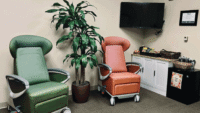It’s no surprise to nurses who choose to work with older adults that many of their current or future colleagues would rather focus on caring for those at the other end of the age spectrum.A 2007 survey by Evercare, a national care-coordination program for older adults and persons with long-term health issues, bears that out. Of the surveyed high school seniors considering a career in nursing, 87% expressed a desire to work in pediatrics, 68% in neonatal areas, and 65% in obstetrics.
But all is not lost. The survey found that giving prospective nurses information about the high demand for geriatric nurses increases their interest in this crucial healthcare area.
“For many young people, the idea of interacting with old people can be scary, or at best, not fun,” says Barbara Resnick, PhD, CRNP, FAAN, FAANP, professor at the University of Maryland School of Nursing and renowned expert in gerontology. “The media certainly play a role in perpetuating a negative image of older adults. You don’t see any TV shows taking place in a long-term care facility. What you often see are images of nurses with babies or nurses saving lives in the ER.”
In long-term-care practice for 31 years, Sherrie Domberger, RNC, CDONA, president of the National Association of Directors of Nursing Administrators/Long Term Care, Inc. (NADONA), notes that she was the only one in her graduating class of 144 who chose to go into gerontologic nursing.
“And every student I’ve spoken with in the past few years seems to want to work in a high-profile, fast-moving area like pediatrics or the ER,” she says. “It’s like they’re comparing work with shopping, and they feel a long-term care facility is like Target, and the hospital or trauma center is like Tiffany’s. Everyone wants to shop at Tiffany’s even if the product is no better than at another store. It’s the prestige that the name carries.”
The demand, the barriers
According to the Population Division of the U.S. Census Bureau, the estimated number of U.S. residents age 65 and older in July 2006 was roughly 37.2 million, and those age 85 and older numbered about 5.28 million. According to the federal government, 330 baby boomers turned age 60 every hour in 2006.What’s scary about providing care to older adults? The answer, gerontologic nurses say, is that many people, especially younger people, think all older adults are frail. And with that frailty comes complex care. Perhaps traditional nursing programs have perpetuated this misconception inadvertently through clinical experiences.
According to the Population Division of the U.S. Census Bureau, the estimated number of U.S. residents age 65 and older in July 2006 was roughly 37.2 million, and those age 85 and older numbered about 5.28 million. According to the federal government, 330 baby boomers turned age 60 every hour in 2006.What’s scary about providing care to older adults? The answer, gerontologic nurses say, is that many people, especially younger people, think all older adults are frail. And with that frailty comes complex care. Perhaps traditional nursing programs have perpetuated this misconception inadvertently through clinical experiences.
“For someone just starting out in nursing, the complexity of care of certain older adults may be threatening,” says Judith Hertz, PhD, RN, president of the National Gerontological Nursing Association (NGNA) and an associate professor of nursing at Northern Illinois University in DeKalb.
To better engage students in older-adult nursing practice, gerontologic nurse practitioner Susan Carlson, APRN, CNS, GNP, suggests a nonstandard educational approach. “When I was a student at a liberal arts college in the 1970s, one of my first nursing classes required establishing a relationship with an older adult who was living independently,” says Carlson, a neurology nurse practitioner at the Audie L. Murphy Memorial VA Hospital in San Antonio, Texas and a former NGNA board member. “It primarily was a way for nursing students to build communicationskills. It was a great idea, because it was not an illness model but a wellness model.”
That initial experience emphasizes the autonomy of many older adults, as well as their connections to family and community—something that might be lacking in certain clinical experiences, says Carlson.
NGNA and gerontologic nurses see aging as a continuum, and that view needs to be communicated broadly to alter the misperceptions associated with providing care to older adults.
“We have many years of being an adult,” Carlson says. “We need to help students and other nurses
to not think of older adulthood as an endpoint but as part of a journey.” (The Evercare survey noted that some students didn’t want to work in geriatrics because they were uncomfortable with end-of-life issues.)
to not think of older adulthood as an endpoint but as part of a journey.” (The Evercare survey noted that some students didn’t want to work in geriatrics because they were uncomfortable with end-of-life issues.)
“Young people are always looking for something they enjoy, and I think there are a lot of missed opportunities for helping new nurses understand the benefits of working with older adults in many different settings,” she adds.
Making inroads
Education and exposure—both informal and formal—are key to shattering myths and ensuring that all older adults get the care they need. Nurses can take the lead in meeting these challenges, according to gerontology nurse experts.“We develop positive attitudes about people or work when we have positive experiences,” Resnick says. “My mother was very respectful of older adults and took care of her parents until she no longer could. So I grew up visiting my relatives in the nursing home. It was a warm and loving experience.
Education and exposure—both informal and formal—are key to shattering myths and ensuring that all older adults get the care they need. Nurses can take the lead in meeting these challenges, according to gerontology nurse experts.“We develop positive attitudes about people or work when we have positive experiences,” Resnick says. “My mother was very respectful of older adults and took care of her parents until she no longer could. So I grew up visiting my relatives in the nursing home. It was a warm and loving experience.
“It’s also vital that student nurses have positive clinicals in assisted living, in long-term care, and in other settings and that students have positive role models.”
Domberger believes long-term care facilities in particular need to open their arms to students for clinical experiences and provide new nurses with strong preceptorship programs that help them learn the role, which calls for a high level of management skills.
There is a persistent belief that long-term care is a place where “we put people to die and that nothing good happens,”
Domberger says. “Many of my residents at the continued-care center are more active than my 40-year-old friends. And on the skilled-care side, nurses can be as clinically challenged as if they were working on a med-surg floor.” She cites current efforts to publicize positive practices and programs within long-term care, including one facility that runs a Make a Wish–type program for older adults.
NADONA, along with many other organizations, is part of a coalition initiative called Advancing Excellence in America’s Nursing Homes, which is designed in part to improve care, increase staff retention, and build public confidence in long-term care. That, in turn, may spark more interest among new nurses.
Getting gero-smart
Carlson, who often sees older adults at her neuro clinic, says it wasn’t until she completed her GNP program that she became truly enlightened about differences between normal aging and the disease process. Working with older adults calls for strong listening and assessment skills, particularly in determining their ability to adapt to physical changes.Although she would like to see more nurses specializing in gerontologic nursing, Carlson says a more realistic view would be to ensure that all nurses are competent to provide care to older patients. Others agree, noting that older adults make up a large part of the patient population in acute-care facilities, including the critical-care areas that attract many new nurses, as well as other RN practice settings.
Carlson, who often sees older adults at her neuro clinic, says it wasn’t until she completed her GNP program that she became truly enlightened about differences between normal aging and the disease process. Working with older adults calls for strong listening and assessment skills, particularly in determining their ability to adapt to physical changes.Although she would like to see more nurses specializing in gerontologic nursing, Carlson says a more realistic view would be to ensure that all nurses are competent to provide care to older patients. Others agree, noting that older adults make up a large part of the patient population in acute-care facilities, including the critical-care areas that attract many new nurses, as well as other RN practice settings.
“New nurses naturally will want to follow their interests, and we want them to be passionate about the types of specialties and settings they choose,” says Mary Jean Schumann, MSN, MBA, RN, CPNP, director of ANA’s Department of Nursing Practice and Policy. “But because of the ever-increasing older population, ANA wants to ensure nurses are prepared to meet these patients’ needs.”
One resource designed to accomplish that goal is ANA’s official geriatric nursing website, www.GeroNurseOnline.org. It was developed through the Nurse Competence in Aging (NCA) initiative, which was funded by The Atlantic Philanthropies (USA) Inc. and awarded to ANA through the American Nurses Foundation. Still in transition, the website will include links to many specialty nursing associations that have been part of the NCA initiative and developed content specifically for their members.
On the media front, Carlson notes that Johnson & Johnson is running commercials that feature a nurse working with an older adult as part of its “Campaign for Nursing’s Future.” She welcomes this positive imagery. (ANA is a partner in the campaign, whose website is www.discovernursing.com.)
Finally, Hertz, an Illinois Nurses Association member, hopes that open conversation will entice students and experienced nurses to eventually specialize in gerontologic nursing.
“I’m always encouraging my students to express their views—positive and negative—and to think about who they’re taking care of in clinicals when they talk about their interest in med-surg, the OR, or critical care. It’s older adults.”
That, she says, is the “Aha!” moment.
That, she says, is the “Aha!” moment.
Susan Trossman is the senior reporter in ANA’s Communications Department.

















